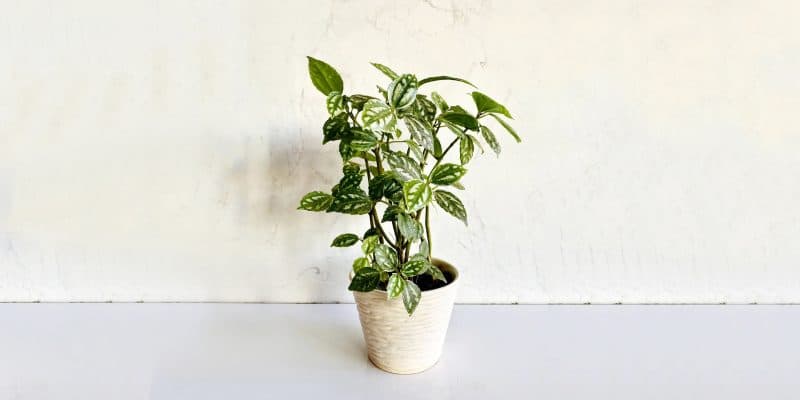The Aluminum Plant has silvery streaks that look almost painted on. It’s a unique-looking houseplant that’s pretty affordable and easy to find.
The Aluminum Plant also has some unique characteristics you should be aware of that can make it a bit tricky to care for — but not too difficult, we promise!
With our Aluminum Plant care guide, you’ll learn everything you need to know to keep it thriving, from selecting the perfect location to the ideal watering routine, and any problems that might arise.
Ready to become an Aluminum Plant expert? Let’s get growing!
Table of Contents
Aluminum Plant Care Guide
History, Habitat, and Characteristics
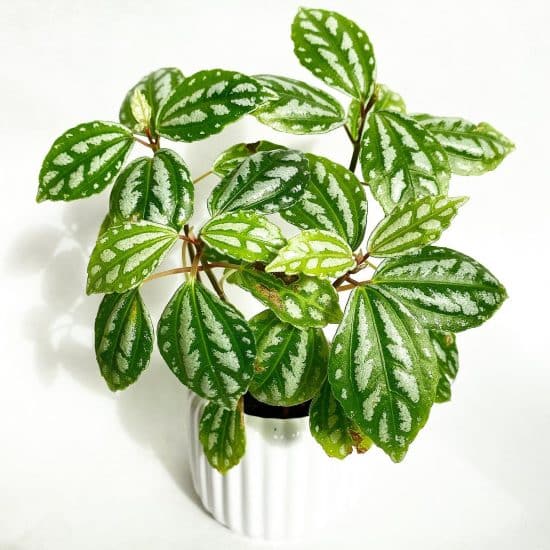
The Aluminum Plant (Pilea cadierei) is an evergreen perennial that looks like it’s been sprayed with aluminum paint. It features leathery-textured, dark-green foliage patterned with silvery streaks.
The best part? These patterns resemble the white and green markings on a watermelon, giving the plant the nickname Watermelon Pilea.
The Watermelon Pilea belongs to the nettle family, Urticaceae, many species of which feature tiny, stinging hairs called trichomes. Luckily, the trichomes on this friendly species don’t sting, making it an excellent indoor plant.
In its natural habitat of southern China and Vietnam, the Watermelon Pilea grows as a ground cover. It loves low-light conditions and remains relatively petite, making it a good companion for small spaces. It has minimal spread as a potted plant and won’t grow much taller than 12 inches.
Although it tends to remain small, Aluminum Plant’s spreading habit means it becomes leggy and less attractive with age. The main Aluminum Plant may not live longer than five years.
Luckily, it’s very simple to propagate, and by keeping it trimmed and propagating it regularly, you can enjoy Aluminum Plant for a long time (we’ll get to how later).
Fun fact: The Aluminum Plant has a long history of herbal uses in Eastern medicine.
Light
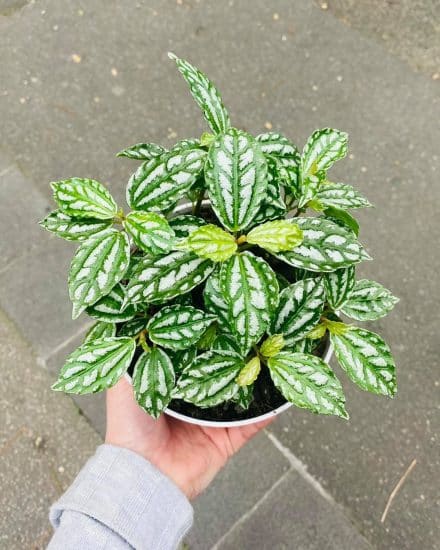
Aluminum Plant isn’t too fussy when it comes to lighting. It flourishes in filtered bright light, but doesn’t mind low-light conditions. However, direct bright light can burn its delicate leaves, so make sure it doesn’t get too much sun.
To ensure your Aluminum Plant is getting enough light, keep an eye out for slow growth or leaves losing their silvery streaks. If leaves seem to be reaching for light or turning toward the closest window, it’s time to find a slightly brighter spot for your houseplant.
On the other hand, if your plant is getting too much direct sunlight, you’ll notice scorching or burning on the leaves, or even some brown spots. In this case, move it a bit farther from the window or hang a sheer curtain to filter out some of that harsh sunlight.
Lighting tips:
- Medium to bright indirect light is ideal.
- Avoid direct sunlight to prevent leaf burn.
- Low-light exposure may suffice.
Water
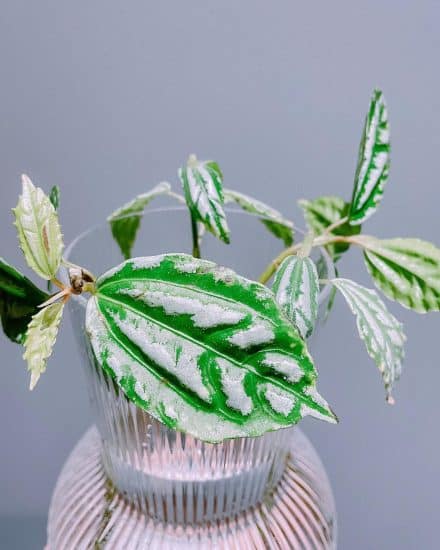
Because Aluminum Plants are small, they stay in smaller pots — and smaller pots mean more frequent watering.
Aluminum Plants thrive in evenly moist soil, and will give you a clear signal when they need water. If your plant becomes limp and droopy, that’s your cue to water it.
A thirsty Aluminum Plant can get very dramatic-looking very quickly, but the good news is that it should perk up within just a few hours of a thorough watering — or sooner.
The Aluminum Plant is a bit on the thirsty side in general, so never let the plant dry out completely. Make it a habit to touch the top quarter inch of soil to check for moisture. If it’s dry to the touch, it’s safe to water.
Although this plant can tolerate a bit of extra water, you don’t want to overdo it. Overwatering is a common problem for the Aluminum Plant, like most houseplants. If the soil becomes saturated and muddy, it’s time to cut down on the frequency.
One sure way to avoid overwatering is to make sure the pot has drainage holes.
Watering tips:
- Use room temperature water.
- Water when the top of the soil is dry.
- Keep the soil evenly moist, not soaking wet.
- Use a pot with drainage holes.
Temperature and Humidity
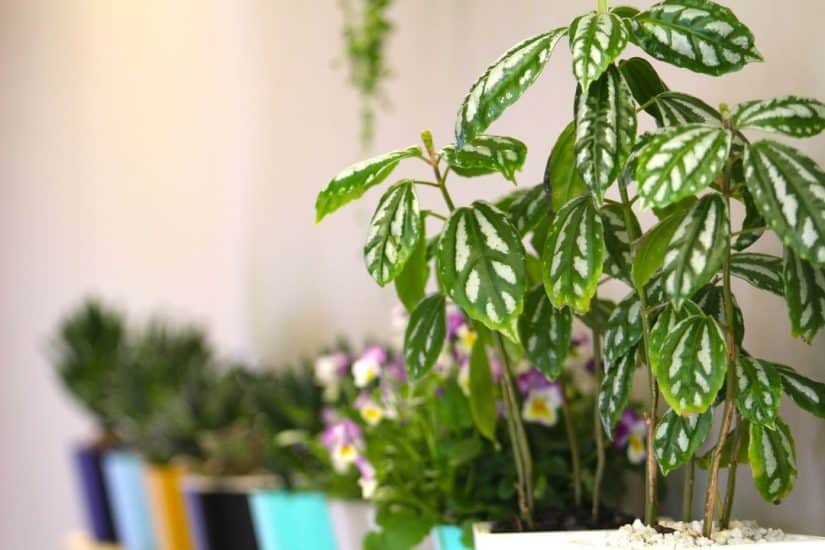
Aluminum Plants enjoy a comfortable room temperature between 65-80°F. Keep this temperature range in mind when placing this plant in your home. Extreme temperatures, too hot or too cold, can stress it out.
Be wary of cold drafts from windows and doors during the winter, and avoid placing your plant near radiators or heating vents that could dry it out or damage the leaves. Likewise, keep it away from air conditioning vents in the summer.
As a tropical plant, the Aluminum Plant needs a relatively humid environment, but it can adapt to less humidity when well watered. To maintain its health and vibrancy, aim for an average humidity of 40%-60% in your plant’s environment.
If the humidity level is too low, you may notice the leaves drooping or tips getting brown and crispy.
On the other hand, if the humidity is too high, your plant might develop diseases like Southern blight, which causes yellowing leaves and a damp or musty smell around the base.
Humidity tips:
- Run a humidifier near the plant for a few hours each day.
- Place the plant on a pebble tray filled with water.
- Mist the leaves regularly (slightly less effective, but fun).
Soil and Planting
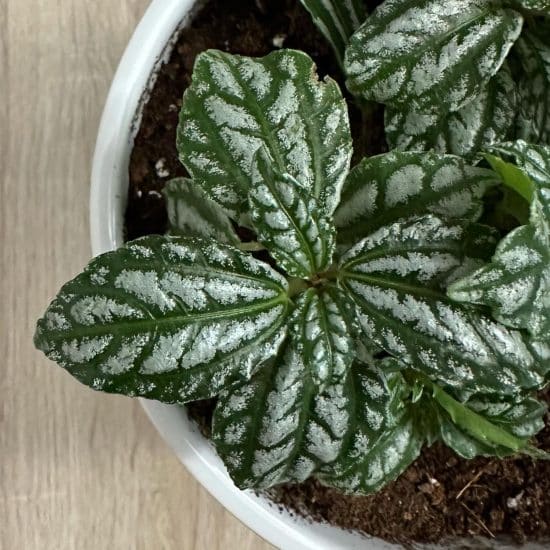
Aluminum Plants prefer a loamy, moist potting mix that retains moisture well. You may be tempted to add peat moss, but we advise using coconut coir instead. It’s more sustainable than peat, and both retains moisture and drains well.
A mixture of fresh soil, coco coir, and a bit of perlite will create the perfect Aluminum Plant fertilizer combination.
When these particular pilea plants are potted in the wrong soil mix or an unsuitable container, they may experience several issues.
Signs of poor soil or potting troubles:
- Yellowing leaves, often caused by inadequate drainage leading to root rot
- Wilting, even when the soil is moist, indicating root or stem damage
- Slow or stunted growth, suggesting insufficient nutrients
If you notice any of these issues, assess your soil composition and container, and make the necessary changes to remedy the situation. The key to success is providing your Aluminum Plant with the right balance of moisture, aeration, and nutrients.
Fertilizer
Aluminum Plants benefit from a well-balanced, diluted, water-soluble fertilizer applied bi-weekly or monthly during the growing season. Using too much fertilizer, however, can be harmful to your plant.
Signs of excessive fertilization:
- Yellowing, burnt, or curled leaf tips and edges, resulting from an excess of soluble salts
- Rapid, weak growth with a pale or washed-out appearance, due to nutrient imbalances
- Root burn or damage, caused by an accumulation of concentrated nutrients
If you suspect that over-fertilization is causing problems for your Aluminum Plant, flush the soil with water, allowing it to drain thoroughly, to remove excess salts. Apply fertilizer less often and potentially in a smaller quantity.
Consider using a time-release fertilizer at the beginning of the growing season, which can provide a steady supply of nutrients without overwhelming the plant.
Propagation Guide
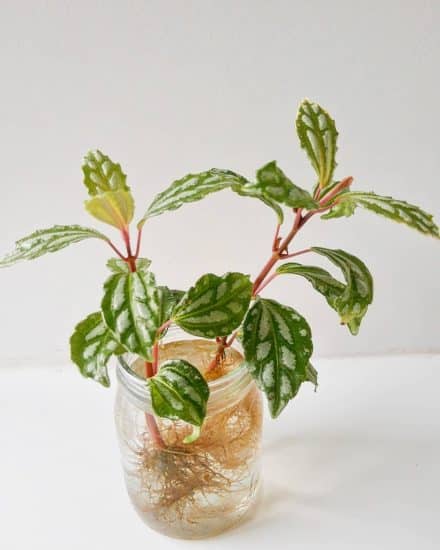
Propagating Aluminum Plant is easier than you might think. We’ll be using the stem cutting method, and before you know it, you’ll have new plants popping up all around you.
Propagate Aluminum Plant by stem cutting:
- Choose the perfect stem: Look for a stem with at least 2-3 leaves. Grab sterilized gardening shears and snip a 4-6 inch segment, ideally just below a leaf node.
- Clean up the stem cuttings: Remove the leaves from the bottom 1-2 inches. Doing this will give the roots some space to grow and keep the leaves from turning into a mushy mess in the water.
- Place in water: Fill a small container with filtered water and place the cutting in there. Make sure the bottom node is in the water and the leaves are not. Find a bright spot for your cutting, but avoid direct sunlight.
- Keep an eye out for roots: Refresh the water every 2-3 days. In about a week, you’ll see the magic happen — tiny roots will start sprouting from the submerged node! Wait until the roots are at least 2-3 inches long before moving on to the next step.
- Transplant your new stem-tip cuttings: Once your cutting has some decent roots, gently place it in a pot filled with well-draining soil. Keep the soil moist and provide bright, indirect light as your new plant grows and thrives.
Common Issues
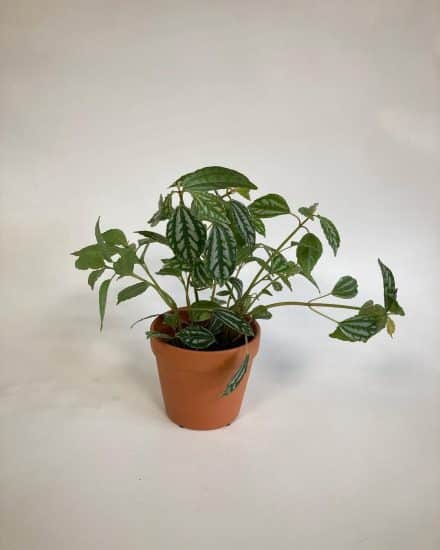
Shedding Leaves
First, let’s determine if it’s just a normal part of your Aluminum Plant’s growth or something more concerning. As these plants grow and develop a spreading habit, they’ll naturally shed some older leaves to make room for new foliar growth.
The best thing to do is trim these leggy stems and propagate them (see our “Propagation Guide” above).
But if you feel like your plant is shedding more than usual, it might be due to inconsistent watering, a lack of light, or other factors messing with your plant’s comfort zone.
To help your Aluminum Plant with excessive leaf drop, make sure it’s getting enough water (but not too much) and bright, indirect sunlight. Pay attention to its surroundings, and tweak them if needed. Soon enough, you should start to see the leaf shedding slow down as your plant adapts to the changes.
Yellow Leaves
There could be a few reasons behind this issue with an Aluminum Plant, including overwatering, insufficient nutrients, or too much direct sunlight.
Overwatering can lead to yellow leaves and root rot, while underwatering may cause the leaves to turn yellow and eventually fall off. Check the soil with your finger and ensure the top of the soil dries out a bit before you water — but don’t wait so long that the whole pot dries out.
Remember, you need evenly moist soil to keep your Aluminum Plant healthy.
If the yellowing continues, consider the nutrients your plant may be missing — a balanced, water-soluble fertilizer might just do the trick. Apply during the growing season in spring and summer, but be sure not to overdo it. Too much fertilizer can be as bad as too little.
And finally, ensure the plant receives medium to bright, indirect sunlight. Too much direct sun can cause its leaves to yellow and even burn.
Pests and Diseases
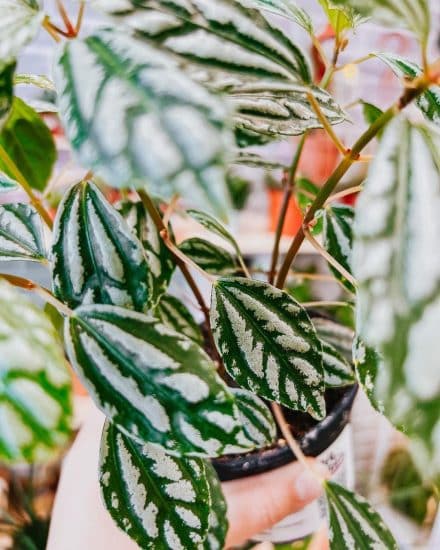
Spider Mites
These tiny little troublemakers can eventually cause your Aluminum Plant’s leaves to yellow or brown. You can diagnose this problem by looking for tiny webs on the undersides of the leaves and at the base of the stems.
Spider mites don’t have to be a death sentence for your Aluminum Plant, though.
First, wipe them away as well as you can. With a damp cloth or cotton swab, give the leaves a gentle rub, or spray the plant with water.
If the mites are still hanging around, apply a neem oil solution, following the directions on the label. Make sure to spray the entire plant, especially the underside of the leaves, where mites love to hide.
To keep spider mites from coming back, stick to your plant’s watering schedule and provide appropriate humidity. Spider mites just adore dry conditions, so keeping the air moist around your plant can deter these invaders.
Don’t forget to inspect your plant regularly for any signs of infestations, and tackle the problem as soon as it pops up.
Fungus Gnats
These tiny, dark-winged insects buzz around the moist soil that your Aluminum Plant loves. While adult fungus gnats won’t really hurt your plant, their larvae (those little white critters in the soil) can damage the roots. Here’s how to kick them out.
First, tackle the moisture in the soil. Let the top inch of the soil surface dry out between waterings and remove any standing water from the saucer beneath the plant. Now, set up some yellow sticky traps to catch adult gnats (it’ll help break their life cycle).
If the gnats persist, you may need to apply Bacillus thuringiensis israelensis (Bti), which targets the larvae without harming your Aluminum Plant. Try Mosquito Bits for an easy way to apply Bti.
For stubborn cases of fungus gnats, the only surefire way to rid your plant of them once and for all is to discard all the old soil and repot your plant in fresh potting soil.
To prevent fungus gnats from returning, pay attention to your watering and soil management. Remember to let the top 1/4 to 1 inch of the soil surface dry out before watering, and use a well-draining soil mix.
And here’s a pro tip: Keep the area around your plant clean and free of decaying plant material to deter fungus gnats from moving in.
Conclusion
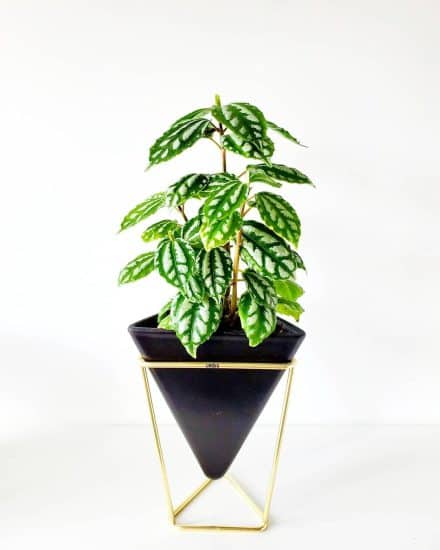
That’s all for our Aluminum Plant care guide! Now you’re equipped with all the knowledge to help this tropical species thrive and shine in your indoor garden.
Aluminum Plant care summary:
- Provide medium to bright, indirect light.
- Avoid direct sunlight.
- Keep the well-draining soil moist but not soaking wet.
- Ensure proper drainage to prevent root rot.
- Aim for a temperature range of 65°-80°F and a humidity level of 40%-60%.
- Fertilize bi-weekly or monthly during the growing season.
We hope these growing tips help you to nurture your new Aluminum Plant. If you found this information useful, don’t hesitate to share it with your fellow plant lovers.
And, as always, feel free to reach out to us with any questions or concerns about your Aluminum Plant — or any other houseplant, for that matter!
Happy growing!
FAQ
Why is it called Aluminum Plant?
Pilea cadierei, or Aluminum Plant, owes its catchy name to the gorgeous, silvery streaks that embellish its lush, green leaves. These metallic patterns have a striking resemblance to aluminum paint, creating a stunning visual effect.
How fast does Aluminum Plant grow?
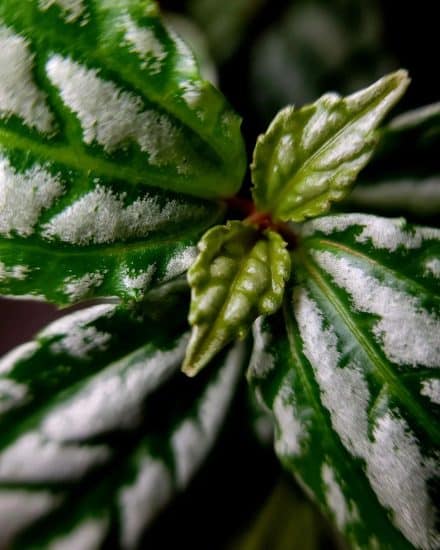
Aluminum Plants are pretty fast growers when they receive the right care, which means you’ll see progress in no time. Keep in mind, though, that they’re likely to become leggy because of their spreading growth habit. Keep long stems trimmed, propagate the stem cuttings, and replant them to encourage a bushier growth.
Are Aluminum Plants toxic?
This houseplant is nontoxic, making it a safe and friendly addition to any indoor space. Though it’s a relative of the stinging nettle family, no stinging nettle genes have made their way to the Aluminum Plant.

